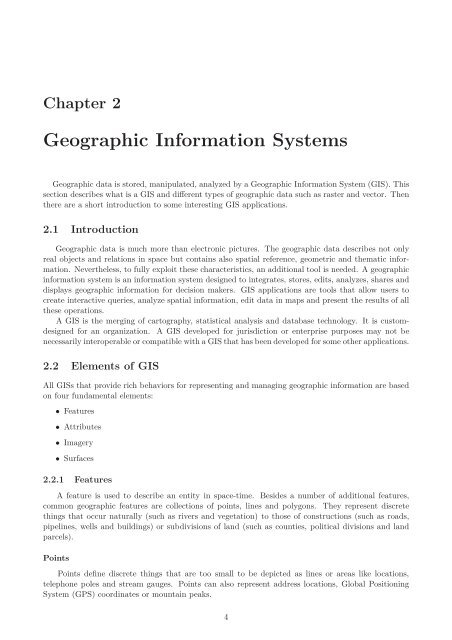PostGIS Raster : Extending PostgreSQL for The Support of ... - CoDE
PostGIS Raster : Extending PostgreSQL for The Support of ... - CoDE
PostGIS Raster : Extending PostgreSQL for The Support of ... - CoDE
You also want an ePaper? Increase the reach of your titles
YUMPU automatically turns print PDFs into web optimized ePapers that Google loves.
Chapter 2<br />
Geographic In<strong>for</strong>mation Systems<br />
Geographic data is stored, manipulated, analyzed by a Geographic In<strong>for</strong>mation System (GIS). This<br />
section describes what is a GIS and different types <strong>of</strong> geographic data such as raster and vector. <strong>The</strong>n<br />
there are a short introduction to some interesting GIS applications.<br />
2.1 Introduction<br />
Geographic data is much more than electronic pictures. <strong>The</strong> geographic data describes not only<br />
real objects and relations in space but contains also spatial reference, geometric and thematic in<strong>for</strong>mation.<br />
Nevertheless, to fully exploit these characteristics, an additional tool is needed. A geographic<br />
in<strong>for</strong>mation system is an in<strong>for</strong>mation system designed to integrates, stores, edits, analyzes, shares and<br />
displays geographic in<strong>for</strong>mation <strong>for</strong> decision makers. GIS applications are tools that allow users to<br />
create interactive queries, analyze spatial in<strong>for</strong>mation, edit data in maps and present the results <strong>of</strong> all<br />
these operations.<br />
A GIS is the merging <strong>of</strong> cartography, statistical analysis and database technology. It is customdesigned<br />
<strong>for</strong> an organization. A GIS developed <strong>for</strong> jurisdiction or enterprise purposes may not be<br />
necessarily interoperable or compatible with a GIS that has been developed <strong>for</strong> some other applications.<br />
2.2 Elements <strong>of</strong> GIS<br />
All GISs that provide rich behaviors <strong>for</strong> representing and managing geographic in<strong>for</strong>mation are based<br />
on four fundamental elements:<br />
• Features<br />
• Attributes<br />
• Imagery<br />
• Surfaces<br />
2.2.1 Features<br />
A feature is used to describe an entity in space-time. Besides a number <strong>of</strong> additional features,<br />
common geographic features are collections <strong>of</strong> points, lines and polygons. <strong>The</strong>y represent discrete<br />
things that occur naturally (such as rivers and vegetation) to those <strong>of</strong> constructions (such as roads,<br />
pipelines, wells and buildings) or subdivisions <strong>of</strong> land (such as counties, political divisions and land<br />
parcels).<br />
Points<br />
Points define discrete things that are too small to be depicted as lines or areas like locations,<br />
telephone poles and stream gauges. Points can also represent address locations, Global Positioning<br />
System (GPS) coordinates or mountain peaks.<br />
4
















